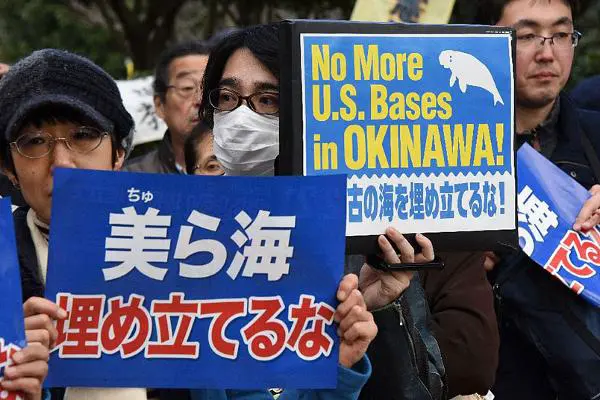The arrest of an American civilian working at a U.S. military base in connection with the slaying of a woman in Okinawa has stirred up bitter memories of crimes committed by those with ties to the U.S. military.
Some of those memories date back decades, underscoring the inability of the Japanese and U.S. governments to stamp out such acts of violence.
The latest incident was mortifying to Australian Catherine Fisher, a rape victim who waged a prolonged legal battle with the hope that it would lead to an end to such crimes by U.S. military personnel in Japan.
On the evening of May 20, she used the Defense Ministry in Tokyo's Ichigaya district as a symbolic backdrop to stage a protest.
"I was raped by a U.S. sailor in Yokosuka in 2002, (but) I was not killed," said Fisher, who has lived in Japan since the 1980s. "That is why I must raise my voice."
In April 2002, she went to Yokosuka in Kanagawa Prefecture south of Tokyo to meet her boyfriend. She was waylaid by a U.S. Navy sailor and raped. She reported the crime to police, but no indictment was handed down. Although she won a civil lawsuit in 2004, the defendant had returned to the United States by that time. She tracked him down and in 2013 won a court ruling in the United States that obligated the man to pay compensation.
Fisher learned about continued sex crimes by U.S. military personnel in Okinawa and continued her legal fight even though she suffered from post-traumatic stress disorder.
According to the National Police Agency and Okinawa prefectural police, in the early 1990s there were close to 300 crimes committed by those with ties to the U.S. military in Japan. The number dropped to 90 in 1996, but by 2003 had risen to 194. The number has hovered at around 100 annually thereafter, with about half of the crimes committed in Okinawa.
Fisher expressed outrage over the latest crime, saying she had sacrificed her life, family and money in her campaign against crimes by U.S. personnel.
"I should be the last victim," she said.
Fisher also said that whenever such crimes are reported, she felt the Japanese government only pretended to be angry while the U.S. government seemed only to pay lip service to its pledges to prevent a recurrence.
Fisher said U.S. military personnel had to be educated that they "cannot run away" if they committed a crime in Japan.
Masanori Yamazaki, a resident of Yokosuka, lost his common-law wife in a robbery-murder case in January 2006.
"I am still frustrated even though 10 years have passed," said Yamazaki, 68. "My wife (to be) did nothing wrong. She suffered the same fate as the victim of the latest incident in Okinawa."
He was engaged to Yoshie Sato, who was 56 at the time. On the way to work, a crew member of a U.S. aircraft carrier approached her ostensibly for directions, but ended up beating her to death.
Even after she fell to the ground, the drunken solider straddled Sato and continued to pummel her.
"The victims are always women and children," Yamazaki said.
Yamazaki and Sato had purchased a condominium a few months earlier and had just begun living together when her life was cut short.
Sato left her apron on a dining room chair before she left that fateful day. Yamazaki has left the apron as it was.
"I hope no one has to endure such sad thoughts," Yamazaki said.
In 2007, Yamazaki formed a group with other bereaved family members who lost loved ones to crimes committed by those in the U.S. military. In that role, he has visited Okinawa a number of times.
"I hope the U.S. military and Japanese government will seriously acknowledge their responsibility and apologize and compensate families so they do not have to unduly suffer any more," he said.
The memory of losing a loved one to a crime does not abate even decades after the incident.
Takemasa Kinjo, 59, of Nago, Okinawa Prefecture, still vividly recalls the white cloth covering the face of his dead mother when he was a senior in high school.
His mother was working at the bar her husband had started when a U.S. soldier entered with the intent of robbing it in 1974. The soldier beat Kinjo's mother on her head with a concrete block, killing her.
The family had moved to the Henoko district of Nago in the late 1950s. Kinjo's mother opposed the idea at first, but his father wanted to open the bar to cater to U.S. military personnel.
At that time, theft and fights involving U.S. military personnel were a common occurrence. Some victims of sex crimes felt there was no point even in reporting the incidents to the police.
Kinjo himself was at first resigned to U.S. military bases in the neighborhood.
However, that all changed after his mother was murdered.
Just the sight of U.S. military personnel made him angry.
After the latest incident, Kinjo told his younger brother, "It has happened again."
He believes the only way to avoid more tragic incidents is to get rid of the bases. But he is also concerned that this view is not shared by the government and the general Japanese population.
(THE ASAHI SHIMBUN)
 简体中文
简体中文

